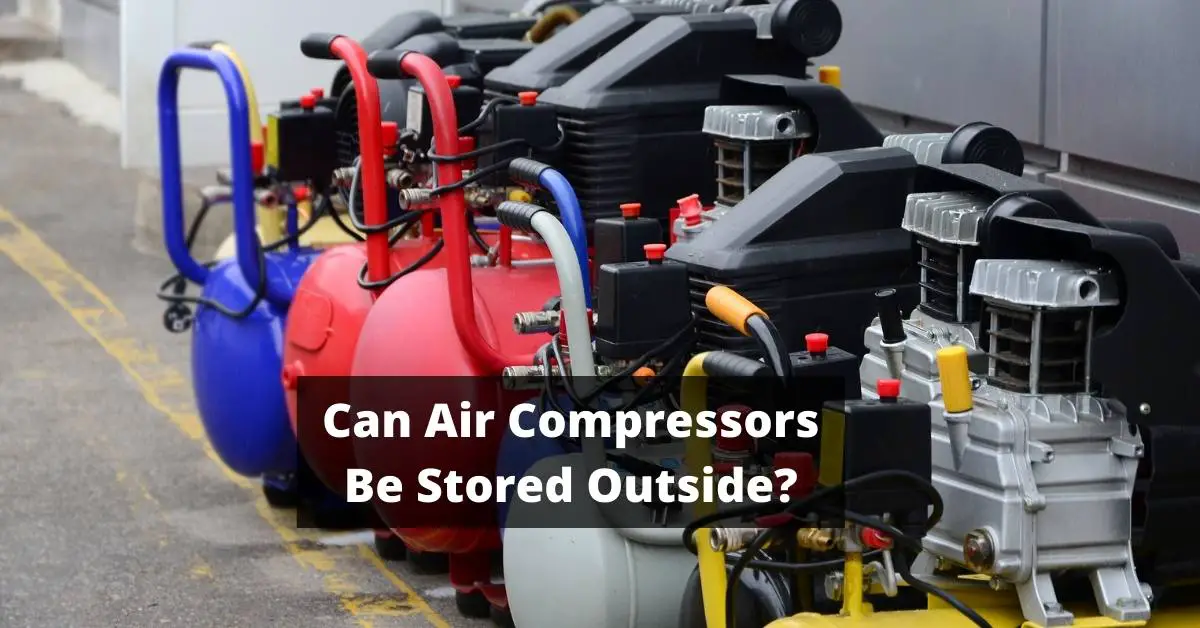I’ve had my fair share of frustrations with air compressors that just won’t turn off. It can be a real headache, especially when you’re in the middle of a project and need to get things done quickly. But don’t worry, I’ve learned a thing or two over the years about troubleshooting these issues.
In this article, I’ll walk you through some common reasons why your air compressor might not be turning off and what steps you can take to fix it.
First up on our list is checking the pressure switch. This little guy is responsible for monitoring the pressure inside your compressor’s tank and automatically shutting off the motor once it reaches a certain level. If it’s faulty or improperly adjusted, it could be causing your compressor to run continuously without ever turning off.
Fortunately, this is usually an easy fix that just requires tweaking the switch settings or replacing the switch altogether. So let’s dive in and see what else could be causing your compressor to stay on all day long!
Check the Pressure Switch
Let’s check if the pressure switch is causing the issue and see if we can get this thing under control. The pressure switch is a vital component of an air compressor that controls its operation. It turns on the compressor when the tank pressure drops below a certain level, and it shuts off the compressor when the maximum pressure limit is reached. If your air compressor won’t turn off, then there might be something wrong with the pressure switch.
To check if the pressure switch is faulty, you need to disconnect it from the power source and remove its cover. Look for any signs of damage or wear on its contacts or wiring. Using a multimeter, test if it’s functioning correctly by checking if it switches between open and closed circuits at different pressures.
If you find any issues with your pressure switch, replace it immediately with one that has similar specifications to your original one. An incorrectly sized or incompatible replacement could cause further problems down the line.
Inspect the air compressor motor to ensure there are no other underlying issues that caused your air compressor not to turn off properly in subsequent sections.
Inspect the Air Compressor Motor
Take a closer look at the heart of your machine, the motor, and see if it’s purring like a content cat or struggling like a car trying to climb a steep hill. One of the reasons why your air compressor won’t turn off is because there could be an issue with the motor.
If the motor is not functioning properly, it can cause the compressor to run continuously without shutting off. It’s important to inspect the motor and check for any signs of wear and tear that may be affecting its performance.
You can start by checking if there are any loose connections or damaged wires in the motor. This can be done by unplugging your air compressor from its power source and removing the cover of your unit to access the motor. Once you have access to it, examine all wiring connections carefully for any signs of damage or looseness. If you find any issues with wiring, this should be addressed immediately before turning on your compressor again.
Another way to inspect your air compressor motor is by looking for signs of overheating such as burnt smells around its vicinity while operating continuously without shutting off. Overheating can cause serious damage to your unit, so make sure you address this issue promptly by seeking professional assistance or replacing parts on your own if you feel confident doing so.
Now that we have looked into inspecting the air compressor motor, let’s move onto our next step – checking for safety valve issues which could also lead to continuous running of an air compressor without shutting off automatically.
Check the Safety Valve
I’d like to discuss the importance of checking the safety valve in your air compressor. As someone who’s had experience with air compressors, I know that understanding your safety valve is crucial to ensuring safe and efficient operation.
Common issues with the safety valve include leaks or a failure to release pressure, which can lead to dangerous situations. If you do encounter these problems, it may be necessary to replace your safety valve altogether.
Understanding the Safety Valve
You need to be aware of the safety valve, as it plays a crucial role in ensuring your compressor doesn’t overheat or cause damage. The safety valve is a small but important component that’s typically located near the air tank. Its primary purpose is to release excess pressure from the tank when it reaches a certain level.
This prevents the compressor from becoming dangerously pressurized, which can lead to overheating and even explosions. Without a properly functioning safety valve, your air compressor could become a serious hazard.
It’s important to regularly check this component for wear and tear, as well as ensure that it’s clean and free of debris. By doing so, you can avoid common issues with the safety valve that might cause problems with your air compressor down the line.
Common issues with the Safety Valve
If your safety valve isn’t working properly, pressure could build up in the tank and cause a dangerous situation. One common issue is that it may become clogged or stuck due to debris or rust buildup. This can prevent it from releasing pressure when the compressor reaches its maximum level, causing the compressor to keep running and potentially overheat.
Another issue is that the safety valve may be worn out or damaged from frequent use or exposure to extreme temperatures. In this case, it may not seal properly when pressure builds up, allowing air to escape and preventing the compressor from turning off.
It’s important to regularly inspect and clean your safety valve to ensure it’s functioning properly, and replace it if there are any signs of damage or wear. This will help prevent potential hazards and prolong the life of your air compressor.
Speaking of replacement…
Replacing the Safety Valve
Now that we’ve talked about common issues with the safety valve, let’s move on to replacing it. As someone who’s had to replace a safety valve before, I can tell you it’s not as difficult as you might think.
First, make sure your air compressor’s unplugged and the tank’s empty. Then, locate the safety valve on your compressor and remove any fittings or hoses connected to it.
Using a wrench or pliers (depending on the type of valve), unscrew the old safety valve from its position and dispose of it properly. Finally, screw in the new safety valve and reconnect any fittings or hoses.
And with that, let’s move onto inspecting the unloader valve.
Inspect the Unloader Valve
I want to talk about the importance of inspecting the unloader valve on your air compressor. Understanding how this valve works is crucial in diagnosing common issues that can arise with it, such as air leaks or failure to build pressure.
If you do find that your unloader valve needs replacing, don’t worry – it’s a relatively simple task that can be done with just a few basic tools.
Let’s dive into this important component and learn how to keep our compressors running smoothly.
Understanding the Unloader Valve
Understanding the unloader valve is crucial for ensuring your compressor doesn’t keep running when it’s not supposed to. The unloader valve is a safety feature that prevents the air compressor from continuously pumping air even when there’s no demand for it.
When you turn on your air compressor, it pumps air into the tank until the pressure reaches maximum capacity and then shuts off. However, if there’s still compressed air in the pump head or discharge tube, this can cause the motor to continue running and put unnecessary strain on both the motor and components.
The unloader valve works by releasing any remaining compressed air in the pump head or discharge tube after you turn off your compressor. This helps to relieve pressure on both the motor and components, preventing them from overworking or being damaged.
Without a working unloader valve, your compressor will continue running even when it’s not supposed to, which can cause overheating, premature wear and tear of parts, and ultimately lead to costly repairs or replacements of major components.
So let’s take a closer look at some common issues with the unloader valve that may be causing your air compressor to stay on unnecessarily.
Common issues with the Unloader Valve
If you’re experiencing problems with your air compressor constantly running, it could be due to issues with the unloader valve. One common issue is that the valve may not be releasing pressure properly, causing the compressor to continuously run even when not in use. This can lead to overheating and damage to the motor over time.
Another issue with the unloader valve is that it may become stuck or clogged with debris, preventing it from functioning properly. This can also result in a constant running of the compressor, as well as reduced efficiency and performance.
If you’re experiencing any of these issues with your air compressor, it’s important to address them promptly before they cause further damage. In the next section, we’ll discuss how to replace a faulty unloader valve for optimal performance of your air compressor.
Replacing the Unloader Valve
To replace the unloader valve, you’ll need to follow these steps to ensure that your air compressor works efficiently and doesn’t overheat or sustain damage.
First, turn off the power supply and disconnect the hoses from the pressure switch.
Next, remove the pressure switch cover and locate the unloader valve. It should be connected to a small tube that runs from the compressor pump head to the pressure switch.
Once you have located the unloader valve, unscrew it from its mounting bracket using a wrench or pliers. Be sure not to damage any of the threads or connections during this process.
Once it is removed, install a new unloader valve in its place by threading it onto its mounting bracket until it is secure.
Finally, reconnect all hoses and wires that were removed earlier and test run your air compressor for proper operation.
With your new unloader valve installed, it’s important to also check the tank check valve for any signs of wear or failure as this can also lead to an air compressor not turning off properly.
Check the Tank Check Valve
The tank check valve may be stuck open, causing air to continuously flow through the compressor. This can happen if debris from the air line clogs up the valve, preventing it from closing properly. I’ve seen this issue before with a customer’s compressor and was able to fix it by cleaning out the valve.
To inspect the tank check valve, first turn off the compressor and detach any hoses or fittings connected to it. Then, remove the cover of the check valve and look for any blockages or damage. If you see debris, use a wire brush or compressed air to clean it out. If there is damage, replace the valve entirely.
If after cleaning or replacing the check valve your compressor still won’t turn off, move on to inspecting the pressure regulator. This component controls how much pressure is in your tank and could also be contributing to your problem.
Inspect the Pressure Regulator
Let’s take a closer look at the pressure regulator and see if it’s causing your compressor to keep running. The pressure regulator is responsible for regulating the air pressure that comes out of your compressor. If it’s faulty, it may not be able to regulate the pressure properly, causing your compressor to run continuously.
To inspect the pressure regulator, start by turning off your air compressor and disconnecting it from any power source.
Once you’ve disconnected your air compressor from any power source, locate the pressure regulator. Inspect it for any visible damage such as cracks or leaks in the body of the regulator or around its connections. Check if there is any debris or dirt present inside that could be clogging up the mechanism and causing it to malfunction. You can use a rag or a brush to clean out any debris that you find.
If you’re unsure about how to inspect or repair the pressure regulator on your own, contact a professional for assistance. A trained technician will have experience working with compressors and will know how to diagnose and fix any issues quickly and efficiently. Don’t hesitate to reach out for help if you’re unsure about what steps to take next – getting an expert opinion can save you time and money in the long run!
Contact a Professional
Oh sure, just call a professional to fix your problem like it’s no big deal. Because clearly, you’ve got all the time and money in the world to waste on something that could be easily fixed with a little effort.
But sometimes, when it comes to air compressors that won’t turn off, calling a professional is the best option. If you’re not familiar with how these machines work or don’t have the proper tools or knowledge to fix the issue yourself, you could end up making things worse.
When you contact a professional, they’ll be able to diagnose the problem quickly and efficiently. They’ll also have access to specialized tools and parts that may be needed for repair. Plus, they’ll know exactly what safety precautions need to be taken when working with an air compressor so that neither you nor your equipment gets damaged during repair.
In addition to saving you time and frustration, contacting a professional can actually save you money in the long run. Trying to fix an air compressor without knowing what you’re doing can lead to further damage or even cause safety hazards if not done correctly. By leaving it in the hands of someone who knows what they’re doing, you can rest easy knowing your machine will be back up and running smoothly in no time.
Conclusion
Well, after investigating the issue of why my air compressor wouldn’t turn off, I can confidently say that it was a combination of factors.
First and foremost, checking the pressure switch is always a good place to start. In my case, the switch was faulty and needed to be replaced.
Next, inspecting the air compressor motor was necessary to make sure it wasn’t overheating or experiencing any other issues. It turned out that everything with the motor was functioning properly.
Another important component to check is the safety valve. This valve is designed to release pressure if it becomes too high, but if it’s malfunctioning then it could cause problems with the compressor turning off.
Inspecting the unloader valve and tank check valve are also important steps in resolving this issue. And finally, checking on the pressure regulator can help ensure that everything is working as intended.
In conclusion, troubleshooting an air compressor that won’t turn off requires attention to detail and an understanding of how all of its components work together. While some issues may require professional assistance, there are many things you can do yourself before resorting to calling in someone else for help. With patience and persistence, you can get your air compressor back up and running like new again!



